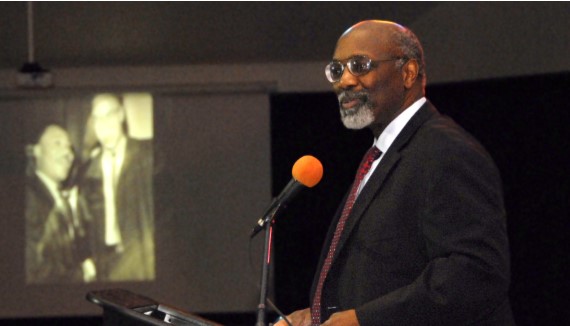
California State University, Dominguez Hills (CSUDH) President Willie J. Hagan delivered the keynote address during the City of Carson’s annual Tribute to Dr. Martin Luther King, Jr. on Jan. 16, touching on the context prevalent during the Civil Rights Movement that influenced Dr. King’s struggles and triumphs, and how faith, obligation and love helped him overcome his fears.
Inspired by the event’s theme “Time to Take a Stand,” Hagan called King “unrivaled in his contribution to the advancement of civil rights in this country.” He quoted his Letter from Birmingham Jail to add additional context to the era: “Millions of blacks were ‘smothering in the airtight cage of poverty in the midst of an affluent society.’” He also called King’s speeches some of the “greatest orations ever delivered.”
“During his time, and centuries before, blacks were denied full and adequate participation in our educational institutions and our political institutions, and denied adequate health care, legal representation, employment opportunities and fair treatment by our businesses,” said Hagan. “Blacks were marginalized, set aside, and left aside.”
President Hagan and the CSUDH Cheer Squad took part in South Los Angeles’ 30th Annual Martin Luther King, Jr. Kingdom Day Parade on Jan. 19, one of largest celebrations in the nation in commemoration of the slain civil rights leader. The theme for this year’s parade was “Love & Respect: Let it Begin with Me.”
Along with Hagan’s address, the program, which took place in Carson’s Congresswoman Juanita Millender-McDonald Community Center, featured the “National Anthem” and “Lift Every Voice and Sing” performed by high school student Tiffany Holmes, and included several other vocal and dance performances by youth groups and others.
Hagan drew parallels regarding recent events in the U.S., such as the death of Trayvon Martin and protests in Ferguson, Missouri, to issues of inequality during the Civil Rights Movement. He also invited the audience to CSUDH’s 9th Annual Martin Luther King, Jr. Symposium and other events taking place on campus during Black History Month in February that will “engage in forthright discussion the issues and the outrage they have generated.”
“The point I want to make is this: the issues of social and economic injustice that produced the conditions that compelled Martin Luther King to take action in the ’50s and ’60s are–despite the improvements–the same underlined conditions that compel today’s protests are marches. They remind us that marginalization still exists in this country, and that the work that Dr. King started is by no means complete,” he said.
Hagan paraphrased data that he believes illustrates the kind of “destructive inequalities” that still exist today; that “more African American men in the U.S. receive their GED in prison than graduate from college (Martinez and Colby, Changing Places, 2010).”
“If we are to change the current context we must continue to stand and march for justice, just as Martin Luther King did,” said Hagan. “We must keep in mind his ultimate goal was individual and collective action to make a difference in our social institutions, our educational institutions, our political institutions … and work to make a difference in our personal constitutions of integrity and morality.”
Hagan noted that King’s “response to his fears” provide the best lesson in how to address and create lasting change.
“He marched, he agitated, and he suffered. He changed the world, and in doing so he paid the ultimate price,” said Hagan. “Dr. King knew that when it comes to injustice, the messages that are the most powerful, enduring and successful are those that are disseminated by the collective through love and determination. They are delivered by those who amplify powerful symbols of equality, by those who effect the most change, and not by those who act alone out of hate or fear.”